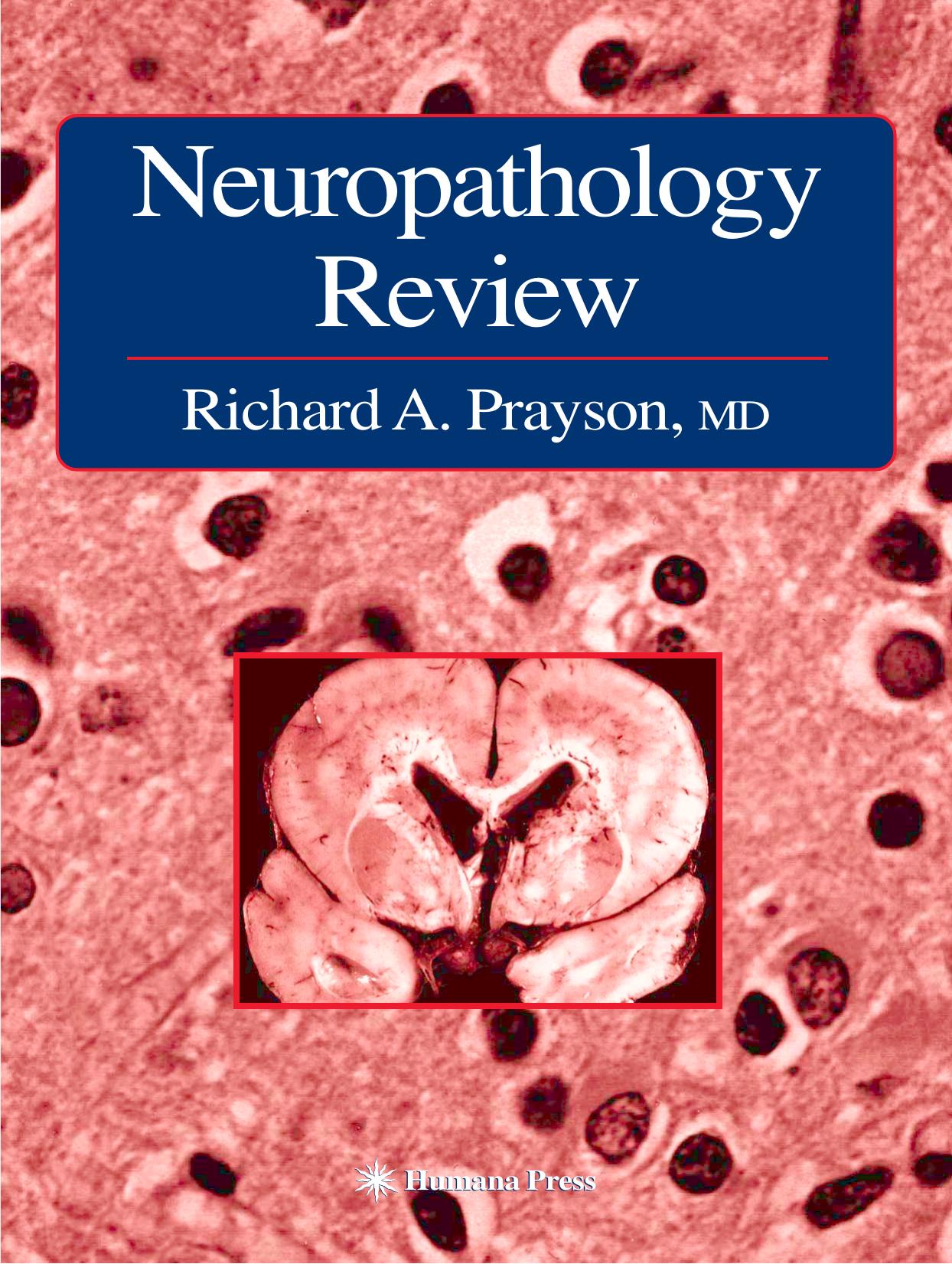Neuropathology Review by Richard A. Prayson

Author:Richard A. Prayson [Prayson, Richard A.]
Language: eng
Format: epub, pdf
Published: 2008-01-15T07:44:00+00:00
10
Skeletal Muscle
I. General Information
A. Muscle biopsy
♦ Do not biopsy muscle that has been recently traumatized-recent needle in it (electromyography [EMG]) or injection site (gluteus, deltoid), severely diseased muscle
♦ Commonly biopsied muscles: quadriceps (vastus lateralis), triceps, biceps, and gastrocnemius
B. Clinical information useful when interpreting a muscle biopsy
• Age
♦ Gender
♦ Drugs/medications
• Medical/family history
♦ EMG findings
♦ Biochemical tests (creatinine kinase [CK], aldolase, myoglobin)
C. A variety of enzyme histochemical stains and special stains are used in the evaluation of biopsy specimens. Many of these stains require fresh or frozen tissue to work. Proper freezing of tissue is important to avoid artifactual distortion of muscle (such as prominent vacuolar changes)
D. Staining of the muscle biopsy specimen
♦ Routine hematoxylin and eosin
• Acid phosphatase
- Lysosomal enzyme
- Increased with degeneration (red staining) - Inflammatory cells
♦ Alkaline phosphatase
- Normal capillary basement stains
- Regenerating fibers (black staining)
♦ Trichrome (Gomori)
- Nuclei red
- Ragged red fibers (mitochondria)
- Inclusion body myositis inclusion (rimmed vacuoles)
- Nemaline rods
- Fibrosis
♦ Periodic acid-Schiff (PAS)
- Normal muscle with glycogen
- Type I > type II
- Glycogen storage diseases
♦ Oil-Red-O
- Normally evenly distributed
- Type I > type II
- Lipid disorders
• Sulfonated alcian blue (SAB)/Congo red
- Amyloid
- Mast cells (SAB positive-internal control)
♦ Nonspecific esterase
- Angular atrophic fibers (neurogenic)
- Acetylcholinesterase
- Type I > type II
- Acute denervation (6 months)
- Some inflammatory cells
♦ NADH
- Oxidative enzyme
- Type I > type II
- Myofibrillary network inside muscle fiber
♦ Cytochrome oxidase
- Mitochondrial enzyme
- Type I > type II
- Focal deficiencies exist
• ATPase (adenosine triphosphatase)
- pH 4.6 (reverse) or pH 4.3
- Type I dark
- Type IIA light
- Type IIB intermediate
- Type IIC light (pH 4.2)
♦ pH 9.8 (standard)
• Type I light
• Type II dark
• Succinate dehydrogenase(SDH)
- Mitochondrial enzyme
- Type I > type II
♦ A variety of other stains may be selectively performed, including myophosphorylase, myoadenylate deaminase, phosphofructokinase, etc.
E. Tissue is often processed in glutaraldehyde or other fixative for potential electron microscopic evaluation
F. In cases of suspected metabolic disease, extra frozen tissue for assay purposes is warranted.
II. Myopathic vs neurogenic changes
A. Myopathic changes-myopathic processes include such disease entities as inflammatory myopathies, muscular dystrophies, congenital myopathies, and metabolic diseases
♦ Irregularity of fiber size
♦ Rounded fibers
♦ Centralized nuclei
♦ Necrotic and basophilic (regenerating) fibers
♦ Cytoplasmic alterations
♦ Interstitial fibrosis
♦ Absence of enzyme staining
♦ Inflammation
♦ Storage of glycogen and lipid
B. Neurogenic changes-neurogenic diseases include those processes that affect the peripheral/central nervous system and result in secondary changes in the muscle
♦ Angular atrophic fibers (esterase positive)
♦ Group atrophy
♦ Fiber type grouping
♦ Target and targetoid fibers
♦ Nuclear bags
♦ No necrotic or basophilic fibers
♦ Minimal interstitial fibrosis
♦ No inflammation
♦ No centralized nuclei
III. Inflammatory Myopathies
A. Polymyositis
♦ Inflammatory myopathies
♦ Nonhereditary
♦ Adults (age 40-60), second peak in childhood
♦ Male:female ratio 1:2
♦ Idiopathic vs association with connective tissue diseases (lupus, rheumatoid arthritis, scleroderma)
♦ An association with neoplasms in adults
♦ Symmetrical proximal muscle weakness, often painful
♦ Fatigue, fever, weight loss
♦ Creatine kinase (CK) and aldolase elevated
♦ PM-l antibody in 50-70%; 40% with Jo-1 antibodies (associated with pulmonary interstitial disease)
♦ Most respond to steroids or other immunosuppressives
♦ EMG-fibrillation potential in acute stage, polyphasic short duration potentials
♦ Histopathology
- Increased variation of myofiber size,
Download
This site does not store any files on its server. We only index and link to content provided by other sites. Please contact the content providers to delete copyright contents if any and email us, we'll remove relevant links or contents immediately.
| Anesthesiology | Colon & Rectal |
| General Surgery | Laparoscopic & Robotic |
| Neurosurgery | Ophthalmology |
| Oral & Maxillofacial | Orthopedics |
| Otolaryngology | Plastic |
| Thoracic & Vascular | Transplants |
| Trauma |
Periodization Training for Sports by Tudor Bompa(8173)
Why We Sleep: Unlocking the Power of Sleep and Dreams by Matthew Walker(6620)
Paper Towns by Green John(5092)
The Immortal Life of Henrietta Lacks by Rebecca Skloot(4528)
The Sports Rules Book by Human Kinetics(4302)
Dynamic Alignment Through Imagery by Eric Franklin(4121)
ACSM's Complete Guide to Fitness & Health by ACSM(3991)
Kaplan MCAT Organic Chemistry Review: Created for MCAT 2015 (Kaplan Test Prep) by Kaplan(3941)
Introduction to Kinesiology by Shirl J. Hoffman(3728)
Livewired by David Eagleman(3686)
The Death of the Heart by Elizabeth Bowen(3554)
The River of Consciousness by Oliver Sacks(3543)
Alchemy and Alchemists by C. J. S. Thompson(3452)
Bad Pharma by Ben Goldacre(3358)
Descartes' Error by Antonio Damasio(3232)
The Emperor of All Maladies: A Biography of Cancer by Siddhartha Mukherjee(3070)
The Gene: An Intimate History by Siddhartha Mukherjee(3050)
The Fate of Rome: Climate, Disease, and the End of an Empire (The Princeton History of the Ancient World) by Kyle Harper(3007)
Kaplan MCAT Behavioral Sciences Review: Created for MCAT 2015 (Kaplan Test Prep) by Kaplan(2941)
